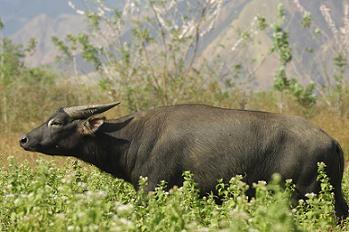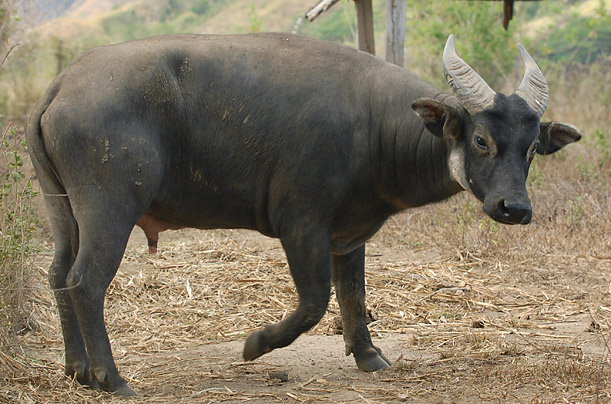The tamaraw or Mindoro dwarf buffalo is the most endangered cattle from the lineage of Asian buffaloes (Bubalus ) and is found only on the island of Mindoro in the Philippines.
The tamaraw is smaller than the water buffalo ( Bubalus bubalis ) and is somewhat similar to the carabao , a domesticated form of the water buffalo and the national animal of the Philippines. In contrast to the carabao the tamaraw what is more hairy, he has horns in a V-shape and light markings on its head.
Another difference between the carabao and tamaraw that the carabao live in herds while tamaraw most of his life a solitary animal. He does not live solitary during the breeding period and just after birth, when the mother the calf suckles for some time. It is thought that the reason they are solitary life lies in the fact that the forests in which they live is a hindrance to the formation of large herds of animals.
The tamaraw grazes on grass plains near the forests where the species lives and can hide from danger. It is thought that the tamaroe long ago appeared on the island Luzon , but today, the species only at two locations on Mindoro: in Mount Iglit-Baco National Park and Mount Aruyan in Sabayan.
~~~
~~~
The tamaroe lives of grass, bamboo and water plants. In captivity they graze during the day an average of 4.5 hours, while the species in the wild, due to human influences, more and more a night grazer has become.
The tamaraw is smaller than the water buffalo ( Bubalus bubalis ) and is somewhat similar to the carabao , a domesticated form of the water buffalo and the national animal of the Philippines. In contrast to the carabao the tamaraw what is more hairy, he has horns in a V-shape and light markings on its head.
Another difference between the carabao and tamaraw that the carabao live in herds while tamaraw most of his life a solitary animal. He does not live solitary during the breeding period and just after birth, when the mother the calf suckles for some time. It is thought that the reason they are solitary life lies in the fact that the forests in which they live is a hindrance to the formation of large herds of animals.
The tamaraw grazes on grass plains near the forests where the species lives and can hide from danger. It is thought that the tamaroe long ago appeared on the island Luzon , but today, the species only at two locations on Mindoro: in Mount Iglit-Baco National Park and Mount Aruyan in Sabayan.
~~~
~~~
The tamaroe lives of grass, bamboo and water plants. In captivity they graze during the day an average of 4.5 hours, while the species in the wild, due to human influences, more and more a night grazer has become.


No comments:
Post a Comment